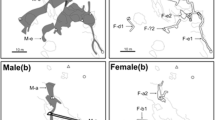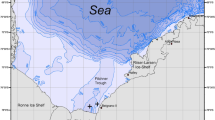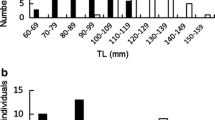Synopsis
The Red Sea seamoth, Eurypegasus draconis, has a social structure that involves close pair-bonding with a monogamous mating system. The occurrence of 61 specimens, 95.1% paired, were recorded in the Gulf of Aqaba, during summers 1989 and 1990. Fourteen pairs were tagged and seven of them were seen again at least once. Cumulative location maps for tagged individuals showed that they were not territorial or site-attached, home ranges of pairs overlapped, they had low mobility, and occurred in low densities. Dissections and histological analyses showed that pairs (n = 12) were heterosexual and all individuals were sexually mature. E. draconis is sexually dimorphic. Females (n = 13) have significantly larger carapace volumes than males (n = 13). In aquaria, pairs spawned repetitively at dusk. At the peak of a spawning rise they released pelagic eggs from which embryos hatched in 24–29h at 27.2°C. Unpaired individuals probably have little opportunity to meet and mate. Close pair-bonding that ensures the availability of a mate, probably evolved as a style for increasing reproductive success in these small fish that occur in low density. E. draconis sheds its skin in one piece every 1 to 5 days.
Similar content being viewed by others
References cited
Barlow, G.W. 1981. Patterns of parental investment, dispersal and size among coral-reef fishes. Env. Biol. Fish. 6: 65–85.
Barlow, G.W. 1984. Patterns of monogamy among teleost fishes. Arch. Fish Wiss. Beih. 35: 75–123.
Barlow, G.W. 1986. A comparison of monogamy among fresh-water and coral-reef fishes, pp. 767–775. In: T. Uyeno, R. Arai, T. Taniuchi & K. Matsuura (ed.) Indo-Pacific Fish Biology: Proc. Second Internat. Conf. on Indo-Pacific Fishes, Ichthyological Soc. Japan, Tokyo.
Barlow, G.W. 1987. Spawning, eggs and larvae of the longnose filefish, Oxymonacanthus longirostris, a monogamous coralivore. Env. Biol. Fish. 20: 183–194.
Barlow, G.W. 1988. Monogamy in relation to resources. pp. 55–79. In: C.N. Slobodchikoff (ed.) The Ecology of Social Behavior, Academic Press, New York.
Baylis, J.R. 1981. The evolution of parental care in fishes, with reference to Darwin's rule of sexual selection. Env. Biol. Fish. 6: 223–251.
Berglund, G., G. Rosenqvist & I. Svensson. 1986. Mate choice, fecundity and sexual dimorphism in two pipefish species (Syngnathidae). Behav. Ecol. Sociobiol. 19: 301–307.
Clark, E. 1983. Hidden life of an undersea desert. Nat. Geog. 164: 129–144.
Clark, E. & J. Pohle. 1992. Monogamy in the tilefish, Malacanthus latovittatus, compared with polygyny in related species. Nat. Geog. Res. Exploration 8: 276–295.
Donaldson, T.J. 1989. Facultative monogamy in obligate coraldwelling hawkfishes (Cirrhitidae). Env. Biol. Fish. 26: 295–302.
Echeverria, T.W. 1986. Sexual dimorphism in four species of rockfish genus Sebastes (Scorpaenidae). Env. Biol. Fish. 15: 181–190.
Emlen, S.T. & L.W. Oring. 1977. Ecology, sexual selection, and the evolution of mating systems. Science 197: 215–223.
Fishelson, L. 1966. Solenostomus cyanopterus Blecker (Teleostei, Solenostomidae) in Elat(Gulf of Akaba). Israel J. Zool. 15: 95–103.
Fishelson, L. 1973. Observations on skin structure and sloughing in the stone fish Synanceja verrucosa and related fish species as a functional adaptation to their mode of life. Z. Zellforsch. 140: 497–508.
Fricke, H.W. 1973. Behaviour as part of ecological adaptation. Helgo. Wiss. Meeresunters. 24: 120–144.
Fricke, H. 1986. Pair swimming and mutual partner guarding in monogamous butterflyfish (Pisces, Chaetodontidae): a joint advertisement for territory. Ethology 73: 307–333.
Ghiselin, M.T. 1969. The evolution of hermaphroditism among animals. Q. Rev. Biol. 44: 189–208.
Grant, E.M. 1978. Guide to fishes, 4th ed. Dept. Harbors and Marine, Brisbane. 421 pp.
Gronell, A.M. 1984. Courtship, spawning and social organization of the pipefish, Corythoichthys intestinalis (Pisces: Syngnathidae) with notes on two congeneric species. Z. Tierpsychol. 65: 1–24.
Humason, G.L. 1979. Animal tissue techniques. W.H. Freeman Co., San Francisco. 661 pp.
Jones, S. & M. Kumaran. 1964. Notes on eggs, larvae and juveniles of fishes from Indian waters. Indian J.Fisher. 11: 232–246.
Jungersen, H.F.E. 1915. Some facts regarding the genus Pegasus. Rept. 84th Meeting Brit. Assoc. Adv. Sci. 1914, Trans. Sec. D, 6: 420–422.
Kuiter, R.H. 1985. The remarkable seamoths. Scuba Diver 3 (3): 16–18.
Knowlton, N. 1979. Reproduction synchrony, parental investment and the evolutionary dynamics of sexual selection. Anim. Behav. 27: 1022–1033.
Leis, J.M. & D.S. Rennis, 1984. The larvae of Indo-Pacific coral reef fishes. New South Wales University Press, Sydney. 269 pp.
Masuda, H. K. Amaoka, C. Araga, T. Uyeno & T. Yoshino. 1984. The fishes of the Japanese Archipelago. Tokai University Press, Tokyo. 437 pp.
Orians, G.H. 1969. On the evolution of mating systems in birds and mammals. Amer. Nat. 103: 589–603.
Palsson, W.A. & T.W. Pietsch. 1989. Revision of the acanthopterygian fish family Pegasidae (Order Gasterosteiformes). Indo-Pacific Fishes 18: 1–38.
Parker, G.A. 1974. Courtship persistence and female guarding as male time investment strategies. Behaviour 48: 157–184.
Pietsch, T.W. 1976. Dimorphism, parasitism, and sex: reproductive strategies, among deep sea ceratoid anglerfishes. Copeia 1976: 781–793.
Pietsch, T.W. 1978. Evolutionary relationship of the seamoth (Teleostei, Pegasidae) with a classification of gasterosteiform families. Copeia 1978: 517–529.
Pressley, P.H. 1981. Pair formation and joint territoriality in a simultaneous hermaphrodite: the coral reef fish Serranus tigrinus. Z. Tierpsychol. 56: 33–46.
Roberts, C.M. & R.F.G. Ormond. 1992. Butterflyfish social behaviour, with special reference to the incidence of territoriality: a review. Env. Biol. Fish. 34: 79–93.
Robertson, D.R., N.V.C. Polunin & K. Leighton. 1979. The behavioral ecology of three Indian Ocean surgeonfishes (Acanthurus lineatus, A. leucosternon and Zebrasoma scopas): their feeding strategies and social and mating systems. Env. Biol. Fish. 4: 125–170.
Sale, P.F. 1980. The ecology of fishes on coral reefs. Ann. Rev. Oceanogr. Mar. Biol. 18: 367–421.
SAS Institute Inc. 1987. SAS/STAT guide for personal computers. Version 6 Edition. Cary. 1029pp.
Shine, R. 1989. Ecological causes for the evolution of sexual dimorphism: a review of the evidence. Quart. Rev. Biol. 64: 419–461.
Sokal, R.R. & F.J. Rohlf. 1987. Introduction to biostatistics, 2nd ed. W.H. Freeman, New York. 363 pp.
Thresher, R.E. 1984. Reproduction in reef fishes. T.F.H. Publications, Neptune City. 399 pp.
Thresher, R.E. & J.T. Moyer. 1983. Male success, courtship complexity and patterns of sexual selection in three congeneric species of sexually monochromatic and dichromatic damselfishes (Pisces: Pomacentridae). Anim. Behav. 31: 113–127.
Tinker, S.W. 1944. Hawaiian fishes. Tongg Publishing Co., Honolulu. 404 pp.
Trivers, R.L. 1972. Parental investment and sexual selection. pp. 136–179. In: B.G. Campbell (ed). Sexual Selection and the Descent of Man, 1871–1971, Adline, Chicago.
Venkateswarlu, T. & G. Verghese. 1980. Occurrence of the batfish, Pyegasus draconis L. (Pegasiformes: Pegasidae) in Lakshadweek (India). Acta Ichthyol. et Pisc. 10: 55–58.
Vincent, A. 1990. A seahorse father makes a good mother. Natural History 12: 34–42.
Wickler, W. & U. Seibt. 1981. Monogamy in crustacea and man. Z. Tierpsychol. 57: 215–234.
Wickler, W. & U. Seibt. 1983. Monogamy: an ambiguous concept. pp. 33–50. In: P. Bateson (ed.) Mate Choice, Cambridge University Press, Cambridge.
Williams, G.C. 1966. Adaptation and natural selection. Princeton University Press, Princeton. 307 pp.
Wilson, E.O. 1975. Sociobiology: the new synthesis. Belknap Press, Cambridge. 697 pp.
Wittenberger, J.F. & R.L. Tilson. 1980. The evolution of monogamy: hypotheses and evidence. Ann. Rev. Ecol. Syst. 11: 197–232.
Zaccone, G. & A. Licata. 1982. Histochemistry and fine structure of the flame cone cells in the skin epidermis of the sea horse fish Hippocampus ramulosus Leach 1814 (Teleostei: Syngnathidae). Arch. Biol. (Bruxelles) 93: 249–266.
Author information
Authors and Affiliations
Rights and permissions
About this article
Cite this article
Herold, D., Clark, E. Monogamy, spawning and skin-shedding of the sea moth, Eurypegasus draconis (Pisces: Pegasidae). Environ Biol Fish 37, 219–236 (1993). https://doi.org/10.1007/BF00004630
Received:
Accepted:
Issue Date:
DOI: https://doi.org/10.1007/BF00004630




